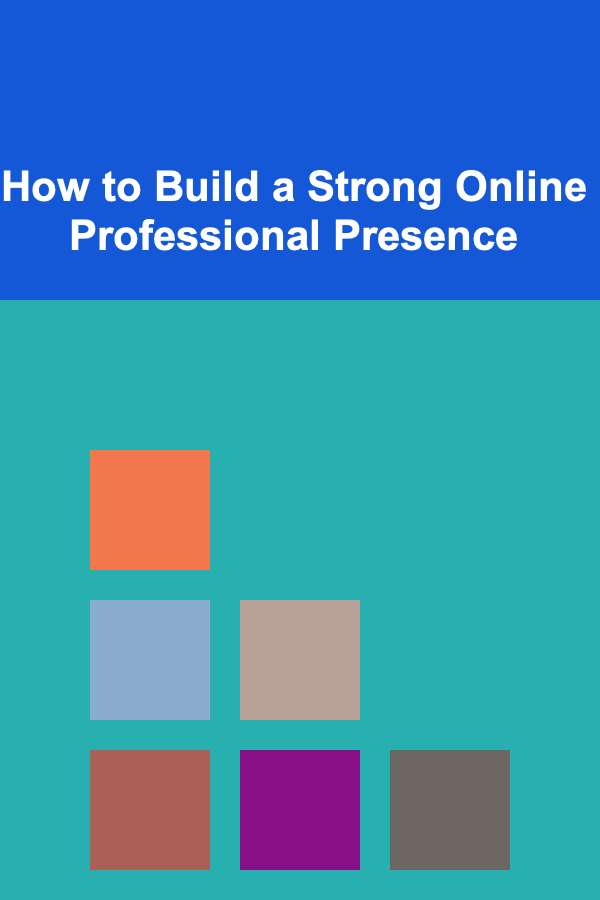
How to Build a Strong Online Professional Presence
ebook include PDF & Audio bundle (Micro Guide)
$12.99$5.99
Limited Time Offer! Order within the next:

In today's increasingly digital world, building a strong online professional presence is crucial for career growth and personal branding. Whether you're a freelancer, entrepreneur, or part of a large corporation, your online presence can significantly impact your reputation, network, and career opportunities. Establishing a compelling digital footprint can open doors to new collaborations, career advancements, and a broader professional network.
This article will guide you through the essential steps to build a robust online professional presence, focusing on strategies that are effective, long-lasting, and scalable.
The Importance of an Online Professional Presence
1.1 The Shift Toward Digital Networking
Gone are the days when professional networks were limited to face-to-face meetings and conferences. With platforms like LinkedIn, Twitter, and personal blogs, professionals now have the power to build relationships and expand their reach beyond geographic boundaries. Digital networking has become the norm, providing opportunities for engagement with industry leaders, peers, and potential clients or employers.
1.2 Brand Building
Just as companies build brand identities, individuals also need to create and maintain a personal brand. This online persona encapsulates your skills, values, and professional interests. A well-established personal brand helps you stand out in competitive job markets and establishes you as an expert in your field. It conveys who you are, what you offer, and why someone should engage with you.
1.3 The Benefits of Building a Strong Online Presence
Having a robust online presence can offer numerous benefits:
- Career Opportunities: Recruiters often search online to evaluate candidates before reaching out. A strong digital presence ensures you're visible to potential employers or clients.
- Networking: The ability to connect with industry professionals, thought leaders, and influencers can be the key to new opportunities and collaborations.
- Thought Leadership: Publishing relevant content and engaging with industry trends can position you as a thought leader in your field, enhancing your credibility.
- Personal Growth: Building an online presence requires you to stay informed and up-to-date with the latest industry developments, promoting continuous professional development.
Step 1: Choose Your Platforms Wisely
Building a professional online presence starts with choosing the right platforms. Your choice should align with your career goals, industry, and target audience.
2.1 LinkedIn: The Professional Network
LinkedIn is one of the most essential platforms for building a professional online presence. It's the go-to social media site for professionals, providing opportunities for networking, job searching, and industry-specific engagement.
- Complete Your Profile: Ensure your profile is fully completed with a professional photo, an attention-grabbing headline, a comprehensive summary, and detailed work experience.
- Use Keywords: Include keywords related to your industry, skills, and expertise. Recruiters often use LinkedIn's search feature to find candidates, so using industry-specific keywords can make you more discoverable.
- Build Connections: Connect with colleagues, classmates, mentors, and professionals within your industry. Don't hesitate to personalize connection requests with a brief message about why you want to connect.
- Engage in LinkedIn Groups: Participate in groups relevant to your industry. This helps you stay updated with trends and connect with like-minded professionals.
2.2 Twitter: Quick Updates and Thought Leadership
Twitter is excellent for quick updates, engaging with industry trends, and showing thought leadership. Many professionals use Twitter to share articles, comment on industry news, and network with influencers.
- Share Insights: Tweet your thoughts on relevant news, trends, or insights in your industry. This will help position you as a knowledgeable professional.
- Follow Industry Leaders: Engage with key thought leaders in your field by commenting on their tweets or sharing their content.
- Use Hashtags: Utilize industry-specific hashtags to make your tweets more discoverable.
- Consistency: Regular posting will help you maintain visibility and keep you top-of-mind within your network.
2.3 Personal Website or Blog: Showcasing Your Expertise
Having a personal website or blog is one of the most powerful tools for building an online professional presence. It serves as your digital portfolio, allowing you to showcase your expertise, achievements, and accomplishments.
- Create a Clean, Professional Design: Your website should have a clean design, easy navigation, and clear calls to action (e.g., contact forms, portfolio links, etc.).
- Post Regular Content: Share your knowledge by writing blog posts that reflect your skills and expertise. Consider topics that are valuable to your target audience.
- Highlight Key Projects: Showcase your best work with detailed case studies, testimonials, and portfolios. This can help potential employers or clients understand the depth of your experience.
- SEO Optimization: Optimize your website's content with keywords to improve your search engine rankings, making it easier for people to find you online.
2.4 Industry-Specific Platforms and Online Communities
Depending on your profession, there may be niche platforms and communities where you can engage with others in your field. For example, GitHub for developers, Behance for designers, or Medium for writers. These platforms allow you to share your work and engage with others in a more specific, specialized way.
- Participate in Discussions: Engage in discussions and offer value. Answer questions, offer advice, and contribute to ongoing conversations in these specialized platforms.
- Share Work and Achievements: Use these platforms to showcase projects that are relevant to the community. Sharing insights on industry-specific topics helps solidify your position as an expert.
Step 2: Optimize Your Profile and Content
Once you've selected your platforms, it's important to optimize your profiles and content to ensure you make the right impression.
3.1 Profile Picture and Bio
Your profile picture is often the first impression people have of you. Choose a professional, high-quality photo that represents you in a positive light. Avoid casual or overly personal images.
Your bio should succinctly summarize who you are, what you do, and what you offer. Make it compelling, using language that highlights your skills, passion, and goals. Include a call to action, encouraging people to connect or follow you.
3.2 Consistent Branding
Consistency is key when building a personal brand. Ensure that your bio, professional summary, and content are aligned across all platforms. This helps reinforce your brand and makes you easier to identify online.
- Use the Same Photo: Use the same professional photo across all platforms to maintain visual consistency.
- Unified Messaging: Ensure that your messaging aligns across all platforms, from your website to your LinkedIn profile to your Twitter bio.
3.3 Content Strategy
Content is at the heart of your online professional presence. Whether you're writing blog posts, creating videos, or sharing insights on social media, the content you produce will help establish your credibility.
- Share Valuable Information: Create content that adds value to your audience. This could be in the form of articles, videos, infographics, or social media posts.
- Showcase Your Expertise: Share your experiences, challenges, and lessons learned in your professional journey. This can be particularly helpful if you're trying to build thought leadership.
- Engage with Others' Content: Engage with content from other professionals by liking, commenting, or sharing. Thoughtful interactions show that you are actively engaged in your industry.
3.4 Be Authentic
Authenticity is crucial for establishing trust and building relationships online. People can easily spot inauthentic behavior, so it's important to stay true to your values and communicate genuinely.
- Personal Touch: While it's important to maintain professionalism, don't be afraid to share your personality and passions. This helps create a more relatable, human connection.
- Avoid Over-Promotion: Focus on adding value rather than self-promotion. While it's okay to highlight your achievements, it's essential to strike the right balance.
Step 3: Engage and Network
Building your online presence is not just about sharing content; it's also about building relationships. Networking plays a vital role in growing your digital reputation and expanding your career opportunities.
4.1 Engage with Your Audience
Actively engage with your audience by responding to comments, messages, and questions. Engaging with others shows that you care about their input and helps strengthen relationships.
- Comment and Respond: Make sure to engage with people who comment on your posts. Responding to messages or feedback will help build a loyal community around your brand.
- Personalized Interaction: Whenever possible, personalize your responses to show genuine interest in the other person's perspective.
4.2 Join and Participate in Communities
Join industry-specific groups on platforms like LinkedIn, Reddit, and Twitter. These groups often feature discussions, job opportunities, and networking events where you can build relationships and learn from others.
- Contribute Value: Share insights, ask questions, and offer advice in these groups. Consistently contributing will help build your reputation and increase your visibility.
- Attend Virtual Events: Participate in webinars, virtual conferences, and online workshops. These events are excellent opportunities to learn, network, and establish yourself as a thought leader.
Step 4: Monitor and Update Your Presence
Building an online presence is an ongoing process. It's essential to monitor your reputation, update your content, and stay engaged with your network.
5.1 Track Analytics
Most social media platforms offer analytics tools that allow you to track engagement, reach, and performance of your posts. Use these insights to refine your content strategy and determine what works best for your audience.
- Measure Engagement: Look for patterns in which content generates the most engagement and refine your approach accordingly.
- Adjust Your Strategy: Based on performance data, tweak your strategy to ensure continued growth and success.
5.2 Keep Your Information Updated
As your career evolves, so should your online presence. Regularly update your profiles with new accomplishments, certifications, or projects.
- Update Skills and Achievements: Ensure that your professional profile accurately reflects your current expertise and accomplishments.
- Stay Current with Trends: Continue learning and staying informed about industry trends. This allows you to create relevant content that resonates with your audience.
Conclusion
Building a strong online professional presence requires strategy, consistency, and authentic engagement. By choosing the right platforms, optimizing your profiles, creating valuable content, and actively networking, you can establish yourself as a respected professional in your field. With dedication and effort, your digital presence will become a powerful tool for career advancement and personal growth.
Remember, your online professional presence is not just about visibility but also about creating meaningful connections, sharing valuable insights, and contributing to your industry. By doing so, you'll not only grow your career but also position yourself as a thought leader in your field.

How to Build a Spring Cleaning Checklist for Outdoor Spaces
Read More
How to Organize Your Essential Oils for Craft Projects
Read More
How to Plan a Kid-Friendly Party That Adults Will Enjoy Too
Read More
How to Secure Your Home Without an Alarm System
Read More
Identifying Marine Fungi and Protists: A Comprehensive Guide
Read More
How to Improve Your Financial Literacy
Read MoreOther Products

How to Build a Spring Cleaning Checklist for Outdoor Spaces
Read More
How to Organize Your Essential Oils for Craft Projects
Read More
How to Plan a Kid-Friendly Party That Adults Will Enjoy Too
Read More
How to Secure Your Home Without an Alarm System
Read More
Identifying Marine Fungi and Protists: A Comprehensive Guide
Read More